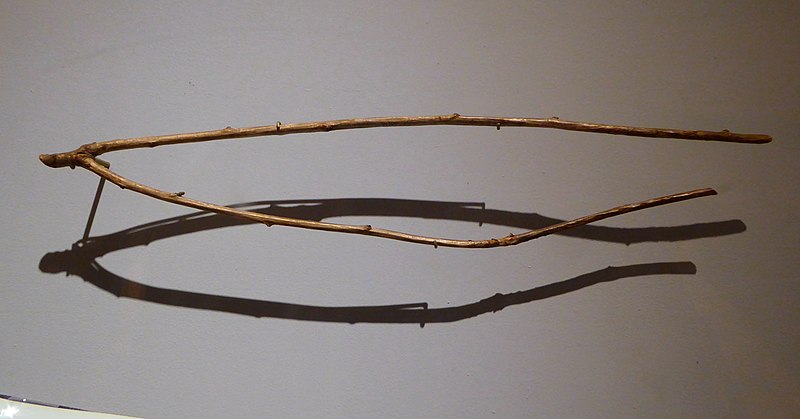Dowsing
|
Many water witches used a forked stick to search for groundwater because they believed that these were channels for their power. This example of a hazel dowsing rod from early 20th century England is part of the Horniman Museum collection. |
Contents |
[edit] Introduction
Dowsing (also known as divining or doodlebugging) is a method believed by some to be a way of locating water, minerals, metals, petroleum, gravesites, lost items or other substances buried underground. When used to detect undiscovered water resources, it is also referred to as water divining, water dowsing, water finding or water witching. Those people who practice water dowsing are sometimes called dowsers, diviners or water witches.
[edit] History
Dowsing has been used for thousands of years. There are African cave paintings 6,000 to 8,000 years old that are thought to illustrate the act of water dowsing. However, the earliest acknowledged evidence of dowsing did not appear until the 16th century, where it was associated with the mining of metals in Germany.
This technique was imported into England by German miners who were recruited to work in different parts of the country. Dowsing was used to find tin, silver, zinc, lead and other valuable materials. The first recorded evidence of its use for locating water also occurred in the 16th century.
Dowsing made its way to the US in the 19th and 20th centuries. It was used by pioneers to locate water wells as the homesteaders, farmers and ranchers attempted to establish settlements in undeveloped areas.
[edit] Tools for dowsing
There are different types of tools that can be used for dowsing. Some dowsers do not use any tools at all, while others use objects such as keys, pliers, pendulums, shovels, pitchforks, glass beads, crowbars or more complicated boxes or electrical devices. The most commonly used tools are Y-shaped tree branches and L-rods.
[edit] Tree branches
Also known as divining rods, vining rods or witching rods, these forked branches sometimes come from a specific type of tree or bush. Common sources include hazel, willow or peach trees.
To use the devices, the dowser holds the twig by the single branch while the Y portion points forward. As the dowser walks, the rod is supposed to move in some way to indicate the presence of whatever material is being sought.
[edit] L-rods
Most commonly made from metal (such as copper), L-rods can be made from materials such as wire coat hangers or electrical cables. L-rods can also be made from glass or plastic.
To use the devices, the dowser holds one rod in each hand with the L portion pointing up and the long portion pointing forward. As the dowser walks, the rods are supposed to cross over to indicate the presence of whatever material is being sought.
[edit] How it works
While dowsing has been dismissed as a hoax, the dowsers have sometimes been successful in their efforts to find water. The US Department of the Interior/Geological Survey says, ‘The natural explanation of "successful" water dowsing is that in many areas water would be hard to miss. The dowser commonly implies that the spot indicated by the rod is the only one where water could be found, but this is not necessarily true. In a region of adequate rainfall and favourable geology, it is difficult not to drill and find water!’
While there is no scientific explanation for the supposed connection between the actions of the dowser and the location of water, psychological connections have been proposed. In the 19th century, dowsing was considered a form of cryptesthesia (a type of telepathy or clairvoyance) which allowed the dowser to produce an unconscious reaction during the search.
Modern theories have associated dowser reactions with other types of unconscious motions sometimes referred to as the ideomotor phenomenon (or ideomotor movements). They are also linked to an electromagnetic effect that occurs when a person’s muscles respond to the presence of the material being sought (although the reaction takes place in a location where there is a high likelihood of the substance being found); the dowsing tool amplifies this response in an action referred to as confirmation bias. In other words, an action occurs primarily because the dowser genuinely wants the tool to work.
[edit] Legitimacy
Despite the lack of scientific evidence, dowsing has been used by military agencies to locate weapons and tunnels (in the 1960s), soldiers buried in avalanches (in the 1980s) and explosive devices in war zones (as recently as 2017).
This technique has been deemed a pseudoscience and has been discredited by most official scientific organisations. However, it is still used as a method of finding water in the UK by some farmers and water engineers. Thousands of water dowsers continue to practice in the US.
The US Department of the Interior/Geological Survey explains that ‘Water dowsers practice mainly in rural or suburban communities where residents are uncertain as to how to locate the best and cheapest supply of groundwater. Because the drilling and development of a well often costs more than a thousand dollars, homeowners are understandably reluctant to gamble on a dry hole and turn to the water dowser for advice’.
[edit] Continued use in the UK
In 2017, it was reported that the majority of UK regional water and sewer companies (10 out of 12) occasionally deployed technicians who used dowsing rods for specific purposes. This practice was sometimes used to find underwater pipes, locate water mains or detect voids that may be caused by bursts or collapses.
While many of the companies later repositioned their actions, these findings were reported to Ofwat. The regulator threatened financial penalties to any firms that failed to halt the activity.
Still, the practice continues to have its supporters. As recently as June 2020, television personality Jeremy Clarkson apparently used the method to locate Victorian era pipes on his land during his programme, Clarkson’s Farm.
After being recommended by one of his neighbours, the technique was deployed by Clarkson, who admitted to being sceptical at first. He fashioned two coat hangers into dowsing tools and went on his quest to find the network of old water pipes.
[edit] Related articles on Designing Buildings Wiki
- Engineering hoaxes.
- Excavation.
- Groundwater.
- Hydrogeology.
- Ley lines.
- Mine.
- Ofwat.
- Sewer construction.
- Tunnel.
- Water engineering.
- Water management strategies.
[edit] External resources
- Driving, Jeremy Clarkson found Victorian pipes on his land through dowsing.
- Sally Le Page, In 2017, UK water companies still rely on “magic”.
- The Guardian, UK water firms admit using divining rods to find leaks and pipes.
- U.S. Department of the Interior/Geological Survey, Water Dowsing.
Featured articles and news
RTPI leader to become new CIOB Chief Executive Officer
Dr Victoria Hills MRTPI, FICE to take over after Caroline Gumble’s departure.
Social and affordable housing, a long term plan for delivery
The “Delivering a Decade of Renewal for Social and Affordable Housing” strategy sets out future path.
A change to adoptive architecture
Effects of global weather warming on architectural detailing, material choice and human interaction.
The proposed publicly owned and backed subsidiary of Homes England, to facilitate new homes.
How big is the problem and what can we do to mitigate the effects?
Overheating guidance and tools for building designers
A number of cool guides to help with the heat.
The UK's Modern Industrial Strategy: A 10 year plan
Previous consultation criticism, current key elements and general support with some persisting reservations.
Building Safety Regulator reforms
New roles, new staff and a new fast track service pave the way for a single construction regulator.
Architectural Technologist CPDs and Communications
CIAT CPD… and how you can do it!
Cooling centres and cool spaces
Managing extreme heat in cities by directing the public to places for heat stress relief and water sources.
Winter gardens: A brief history and warm variations
Extending the season with glass in different forms and terms.
Restoring Great Yarmouth's Winter Gardens
Transforming one of the least sustainable constructions imaginable.
Construction Skills Mission Board launch sector drive
Newly formed government and industry collaboration set strategy for recruiting an additional 100,000 construction workers a year.
New Architects Code comes into effect in September 2025
ARB Architects Code of Conduct and Practice available with ongoing consultation regarding guidance.
Welsh Skills Body (Medr) launches ambitious plan
The new skills body brings together funding and regulation of tertiary education and research for the devolved nation.
Paul Gandy FCIOB announced as next CIOB President
Former Tilbury Douglas CEO takes helm.
UK Infrastructure: A 10 Year Strategy. In brief with reactions
With the National Infrastructure and Service Transformation Authority (NISTA).

























Comments
I have used the 'L-rods' (actually I find welding rod to be the best) to locate all sorts of things. Only last week I located and plotted the route of a 'lost' water main for a neighbour which was then confirmed by excavation. I do not claim I can tell you what the object is below ground, its depth etc., but I will tell you it's there. However, when my students try it, some (a small proportion) get no reaction at all to a known drain line.
I once located several drains runs under a school playground which minimised surface damage by ensuring excavation was localised - and when the first drain was exposed, I received a round of applause from a very sceptical construction crew!
I have no mystic powers - but if something works - then use it.
Tony S - Architect.